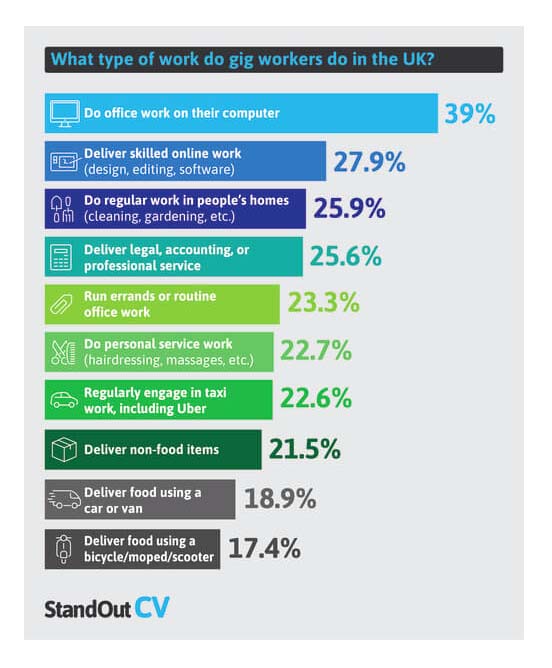Onboarding gig workers (also known as “contingent workers”) is top of mind at many organisations, as companies turn to the fast-growing pool of flexible, non-permanent workers including consultants, freelancers, and independent contractors. Contingent workers are temporary employees that are hired for a specific period, such as covering for an employee on maternity leave, or for a particular project, and are generally expected to meet specific terms defined for the job they’re performing. Because their tenure is temporary, getting onboarding for your gig workers right is critical to both their success and the company’s investment.
Before we dive into best practices for onboarding gig workers, it’s important to first appreciate how prevalent contingent work has become. The last year has seen a significant increase in the number of gig workers. In the UK, 1 in 7 adults has performed contingent work, and as of October 2021, there were just under 4.3 million self-employed workers in the UK, according to Statista. This represents a steady increase in self-employment in the United Kingdom, which was at 3.2 million people in December 2000, and rose to over 5 million at the beginning of 2020.
The popularity of contingent work is on the rise in the US, as well. Statista reports the number of gig workers in the U.S.A is growing at an annual rate of 64.8% and is predicted to continue accelerating, forecasting a whopping 90.1% increase by 2028.
Why is it important to fully integrate contingent workers into the workforce?
“The only difference between contingent workers and your full-time employees is the terms of their employment,” notes Stefan Wissenbach, founder and CEO of Engagement Multiplier. “Otherwise, they need the same things other employees do if they’re to do their best work, and they probably need those things quickly if they’re expected to deliver results within a short timeframe.”
Time spent on onboarding is well-spent, even though it might not seem like it at the outset. According to SHRM, new employees who go through structured onboarding are 50% more productive. Simply put, time spent onboarding is well spent.
The more easily a new employee can navigate the workplace, the less likely they will be to step on toes or unwittingly run afoul of the organisation’s norms. Put another way, they’ll “fit in” and be able to concentrate on building relationships and doing work, rather than trying to parse the way things are done.”
Integrating your new contingent employees is important for their productivity – and other reasons, including:
- Inclusion in culture. Connecting new employees of all stripes to the culture is vitally important – and easy to overlook. For your culture to thrive and grow stronger, employees need to be active proponents, even contingent workers. (Find more information on how to integrate gig workers into company culture in our previous article).
- Alignment with values. Most organisations have created a values system that sets expectations for behaviour. Ensuring your contingent workers are familiar with the organisation’s “operating system” helps them assimilate more quickly.
- Disruption to other teams and projects. A smooth entry and swift assimilation keeps your existing employees and in-flight projects focused and on track.”
How to help contingent workers feel part of the larger team
“Making contingent workers feel part of the team starts before they show up for the first day,” notes Stefan. “When they walk in the door on the first day, they should they know where to go, where to park, find someone is there to greet them when they arrive, and their workstation and equipment should be clean, operational, and ready to go. These are more than thoughtful actions – they make a lasting and positive first impression.”
Other things you can do to make them truly feel part of the team include:
- Pre-schedule introductory meetings with the teams and stakeholders with whom they will be working, and provide context in terms of achieving mutual success. Arranging for lunch meetings for the first several days is a nice touch.
- Assign them a buddy or mentor who can show them the ropes and answer the inevitable questions all new employees – regardless of status – have in their first few weeks. This simple act will prevent frustration and wasted time, and will your new team member to acclimate more quickly.
- Set up some quick wins that will help your new worker contribute quickly and meaningfully to the team. This will not only boost their confidence, but it will also increase others’ confidence in the new joiner, as well.
What does successful integration look like?
Determining what good looks like for integrating your contingent workers can include a variety of factors, including whether the worker achieves the goals you’ve set to feedback from their peers and stakeholders on their experience working with temporary workers.
“I also believe in consistently gathering the contingent workers’ assessment of their experience,” says Stefan. “If you are rigorous about this, you will be able to see patterns in the data that correlate with success or failure. I recommend routinely asking new hires (including contingent workers) for their feedback about their experience.”
To gather a clear view into the onboarding experience, ask your new team members – including gig workers – about the things you know should be true, such as:
- Whether they have a clear understanding of their remit, role, and responsibilities
- If their manager was supportive and present for them
- Were they provided with the tools and resources they needed to do their job
- Were their peers and colleagues were collaborative and willing to share needed information
- Whether they were treated with respect
- Did they feel their contributions were valued
- Did they believe they were treated fairly
- Their manager provided useful feedback promptly
- They have developed good relationships with team members and peers
- They feel a sense of purpose and belonging.
“I always like to invite open-ended feedback questions as well,” Stefan adds. “Two of my favourites are “How did taking this survey make you feel?” and “How would you recommend we improve the onboarding experience?” You can get some incredible insights from asking for focused feedback.”
With this information, a leader can immediately take action to resolve any issues that may be identified, as well as continually improve the onboarding process for contingent staff.



